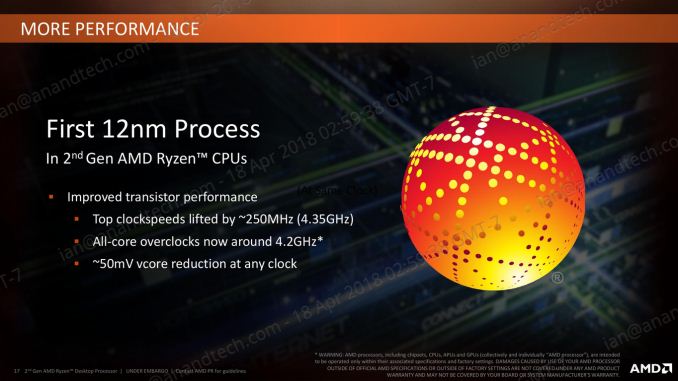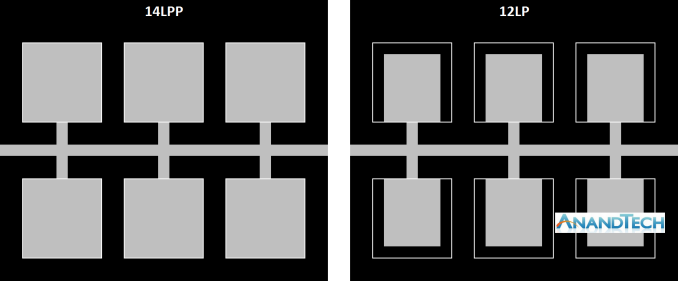The AMD 2nd Gen Ryzen Deep Dive: The 2700X, 2700, 2600X, and 2600 Tested
by Ian Cutress on April 19, 2018 9:00 AM ESTTalking 12nm and Zen+
One of the highlights of the Ryzen 2000-series launch is that these processors use GlobalFoundries’ 12LP manufacturing process, compared to the 14LPP process used for the first generation of Ryzen processors. Both AMD and GlobalFoundries have discussed the differences in the processes, however it is worth understanding that each company has different goals: AMD only needs to promote what helps its products, whereas GlobalFoundries is a semiconductor foundry with many clients and might promote ideal-scenario numbers. Earlier this year we were invited to GlobalFoundries Fab 8 in upstate New York to visit the clean room, and had a chance to interview Dr. Gary Patton, the CTO.
The Future of Silicon: An Exclusive Interview with Dr. Gary Patton, CTO of GlobalFoundries
In that interview, several interesting items came to light. First, that the CTO doesn’t necessarily have to care much about what certain processes are called: their customers know the performance of a given process regardless of the advertised ‘nm’ number based on the development tools given to them. Second, that 12LP is a series of minor tweaks to 14LPP, relating to performance bumps and improvements that come from a partial optical shrink and a slight change in manufacturing rules in the middle-line and back-end of the manufacturing process. In the past this might not have been so news worthy, however GF’s customers want to take advantage of the improved process.
Overall, GlobalFoundries has stated that its 12LP process offers a 10% performance improvement and a 15% circuit density improvement over 14LPP.
This has been interpreted in many ways, such as an extra 10% frequency at the same power, or lower power for the same frequency, and an opportunity to build smaller chips.
As part of today’s launch, AMD has clarified what the move to 12LP has meant for the Ryzen 2000-series:
- Top Clock Speeds lifted by ~250 MHz (~6%)
- All-core overclocks around 4.2 GHz
- ~50 mV core voltage reduction
AMD goes on to explain that at the same frequency, its new Ryzen 2000-series processors draw around 11% less power than the Ryzen 1000-series. The claims also state that this translates to +16% performance at the same power. These claims are a little muddled, as AMD has other new technologies in the 2000-series which will affect performance as well.
One interesting element is that although GF claims that there is a 15% density improvement, AMD is stating that these processors have the same die size and transistor count as the previous generation. Ultimately this seems in opposition to common sense – surely AMD would want to use smaller dies to get more chips per wafer?
Ultimately, the new processors are almost carbon copies of the old ones, both in terms of design and microarchitecture. AMD is calling the design of the cores as ‘Zen+’ to differentiate them to the previous generation ‘Zen’ design, and it mostly comes down to how the microarchitecture features are laid out on the silicon. When discussing with AMD, the best way to explain it is that some of the design of the key features has not moved – they just take up less area, leaving more dark silicon between other features.
Here is a very crude representation of features attached to a data path. On the left is the 14LPP design, and each of the six features has a specific size and connects to the bus. Between each of the features is the dark silicon – unused silicon that is either seen as useless, or can be used as a thermal buffer between high-energy parts. On the right is the representation of the 12LP design – each of the features have been reduced in size, putting more dark silicon between themselves (the white boxes show the original size of the feature). In this context, the number of transistors is the same, and the die size is the same. But if anything in the design was thermally limited by the close proximity of two features, there is now more distance between them such that they should interfere with each other less.
For reference, AMD lists the die-size of these new parts as 213mm2, containing 4.8 billion transistors, identical to the first generation silicon design. AMD confirmed that they are using 9T transistor libraries, also the same as the previous generation, although GlobalFoundries offers a 7.5T design as well.
So is Zen+ a New Microarchitecture, or Process Node Change?
Ultimately, nothing about most of the Zen+ physical design layout is new. Aside from the manufacturing process node change and likely minor adjustments, the rest of the adjustments are in firmware and support:
- Cache latency adjustments leading to +3% IPC
- Increased DRAM Frequency Support to DDR4-2933
- Better voltage/frequency curves, leading to +10% performance overall
- Better Boost Performance with Precision Boost 2
- Better Thermal Response with XFR2













545 Comments
View All Comments
msroadkill612 - Thursday, April 19, 2018 - link
Forbes:"Two weeks ago, if you were building a PC purely for games, I'd have said go with Intel. Today, I'd say you have a choice, and that's a hugely important development."AndersFlint - Thursday, April 19, 2018 - link
I think maybe you've stuffed up your testing somewhere, every other review I've seen paints a different picture, with the 8700k walking all over the 2700x in gaming performance (50+FPS difference in places).Even your cinebench scores are a little off, 1395 for an 8700k?? At stock it should be closer to 1495 and OC around 1695.
Discounting margin or error, this review really is the outlier when put alongside reviews from Hardware unboxed/Gamers Nexus/Linus Tech Tips etc al.
ACE76 - Thursday, April 19, 2018 - link
Anandtech isn't the only review site to come up with this conclusion...other sites are likely either lying or using old scores before all the patches came out...the only testing results worthwhile are those that setup a new testbed using fresh install of Windows, all patches available, latest chipset driver's, video driver's and the latest BIOS.Kankipappa - Friday, April 20, 2018 - link
1400 is the real stock number for 8700 and 8700k. Just because original 8700K youtube reviewers had multi core enhancement support as default (where the turbo clocks go 4.7ghz on all cores, aka out of spec overclock), doesn't make it the real number for your average consumer machine, that doesn't have the option for it nor the TDP headroom.Cooe - Friday, April 20, 2018 - link
Look at Techradar, same results as AnandTech. It's the new Meltdown & Spectre patches it seems. 1 site having weird results is one thing, but that's not what we are seeing here.mapesdhs - Saturday, April 21, 2018 - link
I can't help thinking people are not reading the intro where it clearly states the tests were done with all patches applied.Ryun - Thursday, April 19, 2018 - link
The dolphin emulator benchmark has the 1700 beating the 2700. Is that right?Thanks for benching the 2700 by the way. Seemed that most interesting of the lineup. It packs quite a punch for 65W! Not sure I'd buy it to save $30 over the 2700X but for a heat/power constrained workstation it would be at the top of my list.
Flying Aardvark - Thursday, April 19, 2018 - link
Yup, I use 65W chips because the form factor I want is worth more to me than benchmark results. My system is fast. Really fast. Any additional speed really wouldn't be noticed. A big case on the floor with enough space for a massive heatsink inside would be noticed for many years. As long as I'm on a relatively recent architecture (Zen1 here), I'm probably getting the majority of the enhancements.I plan on buying the Zen2 65W chip as an upgrade with X570.
osamabinrobot - Thursday, April 19, 2018 - link
hey way to go amd!CrazyElf - Thursday, April 19, 2018 - link
Good work and thanks for the review.AMD has made some progress on refining Ryzen and I will be upgrading to Threadripper 2 when it comes out in 2019.
The only disappointment is that 4.4 to 4.5 GHz does not seem to be possible. Then again, it may be by the time Threadripper+ comes around. The original Ryzen did 3.8 to 4.0 GHz, while Threadripper was capable of 4.0 to 4.2, and even a few golden chips did 4.3 GHz.
In terms of performance vs cost this is a solid win for AMD. I just wish that it was possible to get AVX 512 onto AMD. Maybe with Zen 2 or 3 it will be.